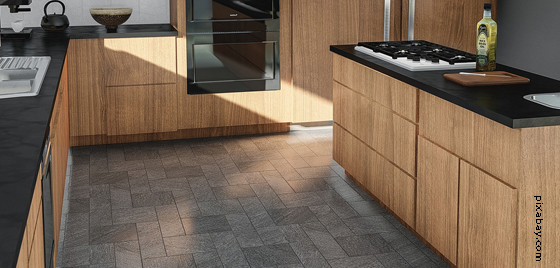
Floor identified as source of pollutants
How to find pollutants in the house
When looking for the source of pollutants in the indoor air, Oliver Zenkel always focuses on the floor first. The building biologist draws on several years of experience and also provides a simple reason. Although walls have the larger surface portion at a dwelling, but floors are usually multi-layered developed and thus substantially more susceptible for pollutant entries into the ambient air. Zenkel views flooring as a system in which not only the individual material plays a role, but also the interaction of the components.
Every layer in the floor can contain residential toxins
The floor structure depends on the choice of material and the type of screed. The classic floor structure looks like this: On top of the raw concrete floor comes a leveling layer, thermal insulation, a separating layer and the screed. Then there is a choice between floating superstructures, for example, as a parquet floor or glued floor coverings. Each individual component could pose a problem. For example, in the 1960s and 1970s, separating layers containing tar were used under the screed, which can release substances containing PAHs for decades. Screed accelerators ensure shorter installation times, but under certain circumstances also solvents containing VOCs in the room air. A separate chapter can be devoted to adhesives and ultimately to visible surface coverings. Here, too, contaminated materials can become a problem. For example, tiles from the 1960s may contain adhesives containing asbestos or even the very toxic polychlorinated biphenyls (PCBs).
Explore indoor contaminants step by step
“In the case of an unknown odor source, I proceed according to the exclusion method,” Oliver Zenkel explains. He first seals the floor with a vapor-tight film and suitable adhesive tapes. After a few days, with the windows closed, it becomes apparent whether the odor is clearly emerging from under the foil covering. If the result is positive, the next step follows. A complete cross-section of the floor is taken out with a core drill and examined for pollutants in the laboratory. Until the laboratory result arrives, the building biologist puts the individual layers of the drill core into separate screw jars and then heats them on the heater. After 24 hours, the first odor samples are taken. Material samples and laboratory results together provide a conclusive result and set the roadmap for remediation. “If no findings come to light in the shut-off method discussed at the beginning, then I examine the wall structure in the next step,” the building biologist explains his plan.
Further information from the Federal Environment Agency Germany
https://www.umweltbundesamt.de/sites/default/files/medien/461/publikationen/4092.pdf
(in German – please translate)
